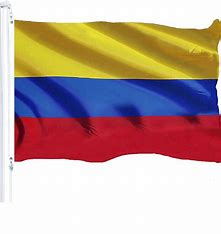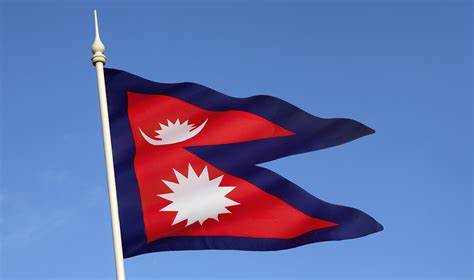
Tourists can embark on a cultural journey through the top 10 historical sites of Nepal, including the ancient Kathmandu Durbar Square, the birthplace of Buddha in Lumbini, and the stunning architecture of Bhaktapur Durbar Square. Explore Nepal’s heritage today.
Some details about the top 10 historical sites in Nepal for tourists:
1. Kathmandu Durbar Square
2. Patan Durbar Square
3. Bhaktapur Durbar Square
4. Swayambhunath (Monkey Temple)
5. Pashupatinath Temple
6. Lumbini
7. Boudhanath Stupa
8. Changunarayan Temple
9. Janaki Temple
10. Gorkha Durbar
1. Kathmandu Durbar Square Nepal.
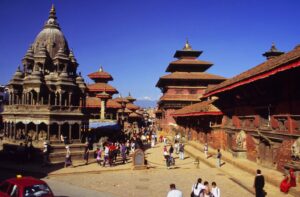
Located in the heart of Nepal’s capital city, Kathmandu Durbar Square is one of the UNESCO World Heritage and historical sites and a cultural hub for tourists looking to explore rich heritage and history of Nepal.
This ancient square is a treasure trove of architectural marvels, temples, palaces, and courtyards that date back centuries, showcasing the intricate craftsmanship and artistic prowess of the Newari people.
One of the highlights of Kathmandu Durbar Square is the Hanuman Dhoka Palace, a sprawling complex that once served as the royal residence of the Malla kings.
Visitors can explore the intricately carved wooden windows, doors, and pillars that adorn the palace, reflecting the opulence and grandeur of Nepal’s royal past.
The square is also home to several stunning temples, including the Taleju Temple, Kumari Ghar (the residence of the Living Goddess Kumari), and the Kasthamandap, believed to be the oldest wooden structure in Kathmandu.
Each of these architectural gems offers a glimpse into Nepal’s religious and cultural heritage, with intricate carvings, statues, and pagoda-style roofs that are a testament to the country’s artistic legacy.
Additionally, tourists can wander through the bustling streets surrounding Kathmandu Durbar Square, exploring vibrant markets, street food stalls, and handicraft shops that offer a taste of local life and traditions.
The square comes alive during festivals and cultural events, providing visitors with an opportunity to witness traditional rituals, dances, and ceremonies that celebrate Nepal’s diverse cultural tapestry.
In conclusion, a visit to Kathmandu Durbar Square is a journey back in time, where history, art, and spirituality converge to create a truly immersive and unforgettable experience for tourists seeking to discover the soul of Nepal.
2. Patan Durbar Square Nepal.
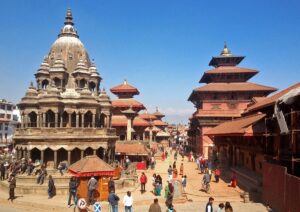
Patan Durbar Square, located in the ancient city of Lalitpur in Nepal, is a UNESCO World Heritage Site that captivates tourists with its stunning architecture, intricate woodwork, and rich cultural heritage.
Furthermore, this square is one of the historical sites of Nepal; tourists can explore the treasures of Newari architecture, which showcases beautifully crafted temples, palaces, and courtyards that date back to the medieval period.
Moreover, one of the highlights of Patan Durbar Square is the Krishna Temple, dedicated to Lord Krishna and adorned with exquisite stone carvings and sculptures.
The temple’s intricate design and craftsmanship are a testament to the skill and artistry of the Newari artisans who built it centuries ago.
Visitors to Patan Durbar Square can also explore the Patan Museum, housed in the former palace of the Malla kings.
The museum displays a collection of religious art, sculptures, and artifacts that offer insights into Nepal’s cultural and artistic heritage.
Strolling through the narrow lanes and alleyways surrounding the square, tourists can discover hidden gems such as traditional Newari houses, artisan workshops, and vibrant street markets selling local handicrafts and souvenirs.
The vibrant atmosphere of Patan Durbar Square provides a glimpse into the daily life and traditions of the local community.
Overall, a visit to Patan Durbar Square is a journey back in time, where history comes alive through the architectural marvels and cultural treasures that adorn this ancient city.
Tourists are sure to be enchanted by the beauty and charm of this historical site, making it a must-visit destination for those seeking a glimpse into Nepal’s rich past and vibrant present.
3. Bhaktapur Durbar Square Nepal.
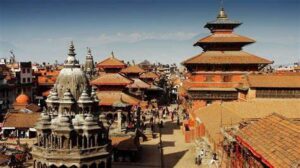
Bhaktapur Durbar Square, located in the heart of Bhaktapur city in Nepal, is a UNESCO World Heritage Site and a must-visit for tourists interested in historical sites culture, and architecture.
Furthermore, this magnificent square is a treasure trove of medieval art and architecture, showcasing the exquisite craftsmanship of the Newar artisans.
Additionally, the square is home to a cluster of ancient temples, palaces, courtyards, and streets that date back to the 12th century.
Among the highlights is the 55-Window Palace, a stunning example of traditional Nepalese architecture. Built in the 15th century, the palace is renowned for its intricately carved wooden windows and doors.
Furthermore, adjacent to the palace is the Vatsala Temple, known for its impressive stone construction, and the Taleju Bell, which was historically used to signal curfews and other important announcements.
One of the most iconic structures in Bhaktapur Durbar Square is the Nyatapola Temple, a towering five-story pagoda built in 1702. It is the tallest temple in Nepal and stands as a testament to the skill of the Newar builders.
Moreover, dedicated to Siddhi Lakshmi, the Tantric goddess, the temple adorns beautiful carvings and sculptures.
Another significant site is the Bhairavnath Temple, dedicated to Bhairava, the fierce manifestation of Lord Shiva.
This temple, with its elaborate artwork, adds to the spiritual ambiance of the square.
Strolling through Bhaktapur Durbar Square, visitors can also enjoy the lively local culture, with artisans at work, traditional music, and vibrant festivals.
The square offers a glimpse into Nepal’s rich cultural heritage, making it a captivating destination for anyone exploring the Kathmandu Valley.
4. Swayambhunath (Monkey Temple) Nepal.
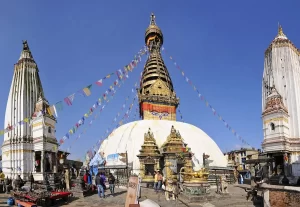
Swayambhunath, commonly known as the Monkey Temple, is one of Nepal’s most revered and ancient religious sites. Perched atop a hill in the Kathmandu Valley, this iconic stupa offers visitors breathtaking panoramic views of Kathmandu city and its surroundings.
Swayambhunath is a significant pilgrimage site for both Buddhists and Hindus, making it a symbol of religious harmony.
The stupa’s origins date back over 2,500 years, making it one of the oldest religious monuments in Nepal. According to legend, the hill emerged spontaneously from a sacred lake that once covered the valley, hence the name Swayambhu, meaning “self-created.”
The main stupa, with its distinctive white dome and gilded spire, topped with a pair of all-seeing eyes, symbolizes enlightenment.
The eyes are said to represent the Buddha’s wisdom and compassion, while the third eye signifies spiritual awakening.
The temple complex is also home to a variety of shrines, temples, and a Tibetan monastery, reflecting the area’s rich cultural tapestry.
Moreover, visitors are often greeted by playful monkeys, considered holy and believed to guard the temple.
Climbing the 365 stone steps to the stupa is a rewarding experience, as the path is lined with prayer wheels and small shrines.
At the top, tourists can immerse themselves in the spiritual ambiance, spin prayer wheels, light butter lamps, and observe the daily rituals performed by monks.
Additionally, chanting fills the air and incense scents create a serene atmosphere.
Swayambhunath is a place of worship and a vibrant cultural hub.
Festivals such as Buddha Jayanti and Lhosar are celebrated with great fervor, offering tourists a chance to witness traditional rituals and local festivities.
Visiting Swayambhunath provides a profound insight into Nepal’s spiritual heritage and cultural richness.
5. Pashupatinath Temple Nepal.
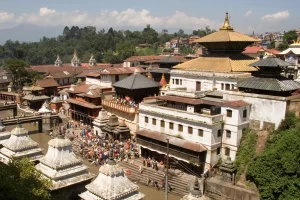
Pashupatinath Temple, located on the banks of the sacred Bagmati River in Kathmandu, is one of the most significant Hindu temples dedicated to Lord Shiva.
Additionally, this sprawling temple complex is one of the historical sites, a UNESCO World Heritage Site, and an essential destination for tourists seeking to experience the rich spiritual and cultural heritage of Nepal.
The main temple, constructed in the Nepalese pagoda style, features a gilded roof, intricately carved wooden rafters, and four silver-plated doors.
Furthermore, it houses the sacred lingam of Lord Shiva, attracting devotees from all over the world.
Some accounts date the establishment of the temple back to 400 AD, shrouding its origins in legend and making it one of the oldest and most revered temples in the region.
One of the most compelling aspects of Pashupatinath is its role as a site for Hindu cremation rituals.
The ghats along the Bagmati River are where the last rites are performed, and witnessing these ceremonies provides a profound insight into Hindu beliefs about life, death, and rebirth.
While these rituals may seem solemn, they are integral to the cultural experience of visiting Pashupatinath.
The temple complex is also home to numerous smaller temples, ashrams, and statues, each with its own historical and religious significance.
The Arya Ghat, for instance, is considered particularly sacred as it is believed that only the most pious souls are cremated here.
Tourists can observe the daily activities of sadhus (holy men) who reside within the temple grounds.
Their vibrant attire and unique practices are a living testament to Nepal’s spiritual diversity.
The annual Maha Shivaratri festival is a particularly auspicious time to visit, as thousands of pilgrims gather to celebrate with night-long vigils, prayers, and offerings.
6. Lumbini Nepal.
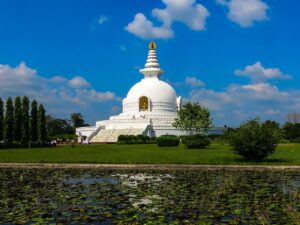
Lumbini, located in the Rupandehi District of Nepal, is a place of immense historical and spiritual significance as the birthplace of Siddhartha Gautama, who later became known as Buddha.
This sacred site in Nepal is one of the historical sites, a UNESCO World Heritage Site, and a must-visit destination for tourists and pilgrims from around the world.
Additionally, the centerpiece of Lumbini is the Maya Devi Temple, which marks the exact spot where Queen Maya Devi gave birth to Buddha around 563 BCE.
Each monastery reflects the architectural style and cultural heritage of its respective nation, providing a unique and diverse spiritual experience.
Moreover, the Royal Thai Monastery, the German Monastery, and the Chinese Monastery are among the notable structures worth visiting.
The peaceful ambiance of Lumbini is perfect for meditation and reflection. Visitors can walk along the serene paths, spin prayer wheels, and participate in meditation sessions conducted by resident monks.
The Eternal Peace Flame, located near the central canal, symbolizes the universal aspiration for peace and harmony.
A visit to the Lumbini Museum offers insights into the archaeological findings and history of the site, enhancing the overall experience.
The museum displays artifacts, manuscripts, and photographs related to the life of Buddha and the development of Buddhism.
Lumbini’s tranquil atmosphere, combined with its profound spiritual significance, makes it an unforgettable destination for those seeking a deeper understanding of Buddhism and the life of Buddha.
7. Boudhanath Stupa Nepal.
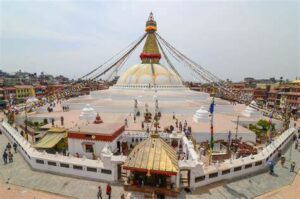
Boudhanath Stupa, located on the northeastern outskirts of Kathmandu, Nepal, is one of the largest and most important Buddhist monuments in the world.
This magnificent stupa in Nepal is one of the historical sites, a UNESCO World Heritage Site, is a central pilgrimage site for Tibetan Buddhists and a significant attraction for tourists seeking spiritual and cultural experiences.
Furthermore, the colossal structure of Boudhanath Stupa stands approximately 36 meters high and dominates the skyline.
Its unique architecture includes a massive white dome topped by a gilded tower, adorned with the all-seeing eyes of Buddha painted on all four sides, symbolizing wisdom and compassion.
108 small images of the Dhyani Buddha Amitabha, each in its own niche, surround the base of the stupa.
Moreover, the stupa’s origins are believed to date back to the 5th century AD.
The atmosphere is serene, filled with the sound of chanting monks and the fluttering of prayer flags, creating a deeply spiritual experience.
The area around Boudhanath Stupa is vibrant with Tibetan culture. The narrow streets are lined with shops selling Tibetan artifacts, thangka paintings, and traditional crafts.
Numerous monasteries and meditation centers offer insights into Tibetan Buddhist practices and teachings.
During the festival of Losar (Tibetan New Year), Boudhanath Stupa comes alive with colorful celebrations, traditional dances, and cultural performances, making it an especially captivating time to visit.
A visit to Boudhanath Stupa offers not just a glimpse into the spiritual heart of Nepal but also an opportunity to immerse oneself in the rich cultural tapestry of Tibetan Buddhism.
8. Changunarayan Temple Nepal.
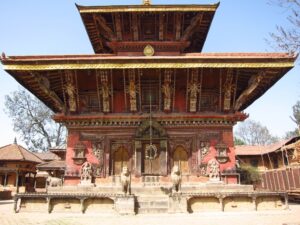
Changunarayan Temple, nestled on a hilltop in the Bhaktapur District of Nepal, is a jewel of ancient architecture and a testament to Nepal’s rich cultural heritage.
This UNESCO World Heritage Site, dedicated to Lord Vishnu, is the oldest Hindu temple in the Kathmandu Valley, with inscriptions dating back to the 4th century.
Furthermore, the temple complex is a splendid example of traditional Nepalese architecture, featuring intricate wood and stone carvings.
The main shrine is adorned with statues and carvings of deities, mythical creatures, and symbols that illustrate stories from Hindu mythology.
Additionally, the two-tiered pagoda-style temple is surrounded by a courtyard filled with sculptures and inscriptions, providing a captivating glimpse into Nepal’s ancient artistry and craftsmanship.
One of the most notable artifacts in Changunarayan Temple is the Garuda Narayana statue, a stunning stone sculpture of Garuda, the mythical bird and mount of Lord Vishnu.
Moreover, this masterpiece is a prime example of the skill and devotion of the artisans who built the temple.
The temple houses significant sculptures, including a life-sized statue of King Bhupalendra Malla and queen.
The serene environment around Changunarayan Temple is perfect for a leisurely stroll, with panoramic views of the Kathmandu Valley and the surrounding hills.
The temple complex is often less crowded than other tourist spots, allowing visitors to explore and appreciate its beauty at a relaxed pace.
For those interested in local culture, the nearby village of Changunarayan offers a chance to experience the traditional Newari lifestyle and hospitality.
The village is known for its pottery and woodcarving, with artisans at work in their shops, creating beautiful souvenirs for visitors.
Visiting Changunarayan Temple provides a profound and peaceful experience, offering a blend of historical, architectural, and spiritual insights into Nepal’s ancient heritage.
9. Janaki Temple Nepal.
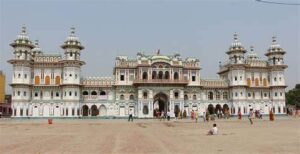
The Janaki Temple, located in the historic city of Janakpur in southeastern Nepal, is a magnificent shrine dedicated to the Hindu goddess Sita, also known as Janaki.
Moreover, this grand temple is a significant Hindu pilgrimage site and an architectural marvel that draws tourists worldwide.
Constructed in 1910 by Queen Brisabhanu Kunwari of Tikamgarh, India, the Janaki Temple is an exquisite example of Mughal and Koiri architecture.
The temple, built entirely of marble and stone, features intricate carvings, beautiful domes, and a large central dome surrounded by smaller ones.
Additionally, artists adorn the facade with vibrant paintings and statues, making it a visual delight.
The temple’s centerpiece is the sanctum housing the statues of Sita and her consort, Lord Rama, along with their brothers Lakshman, Bharat, and Shatrughna.
Pilgrims and visitors alike beautifully decorate and worship the deities with great devotion.
The temple complex also includes courtyards, gardens, and numerous smaller shrines, providing a serene and spiritual atmosphere.
One of the most celebrated events at Janaki Temple is the annual Vivah Panchami festival, commemorating Sita and Rama’s divine marriage.
During this festival, the temple and the entire city of Janakpur come alive with vibrant processions, traditional music, dance, and rituals.
Furthermore, the festivities attract thousands of devotees, offering a unique cultural experience for tourists.
People steep Janakpur in history and mythology, believing it to be the birthplace of Sita and the site of her marriage to Rama.
Visitors can explore the ancient ponds, sacred sites, and vibrant bazaars that reflect the city’s rich cultural heritage.
A visit to the Janaki Temple offers a spiritual journey and a chance to admire the architectural beauty and immerse oneself in the cultural traditions of Nepal.
10. Gorkha Durbar Nepal.
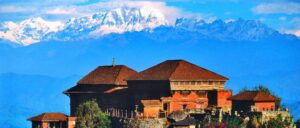
Gorkha Durbar, located in the picturesque hill town of Gorkha in central Nepal, is a historical gem that offers tourists a fascinating glimpse into the rich heritage of the region.
This historic palace-fortress is perched atop a hill, providing breathtaking views of the surrounding valleys and the majestic Himalayan peaks, including Manaslu and the Ganesh Himal range.
King Prithvi Narayan Shah, the unifier of modern Nepal, was born in Gorkha Durbar, a place renowned for its 16th-century architecture.
Additionally, the complex includes a fortified palace, temples, and courtyards, blending traditional Nepali architecture with strategic military design.
The main palace, with its intricately carved wooden windows and doors, reflects the exquisite craftsmanship of the Newar artisans.
Moreover, a highlight of the Gorkha Durbar complex is the Gorkhanath Temple, dedicated to the deity Gorakhnath.
The temple is an important pilgrimage site, drawing devotees who come to seek blessings and pay their respects.
Another significant temple within the complex is the Kali Temple, dedicated to the fierce goddess Kali, symbolizing power and protection.
The journey to Gorkha Durbar is an adventure in itself, involving a scenic hike or drive through terraced fields, lush forests, and traditional villages.
The path is adorned with prayer flags and offers opportunities to observe rural Nepali life and interact with the local Gurung and Magar communities.
Visitors to Gorkha Durbar can also explore the nearby Gorkha Museum, which houses artifacts, photographs, and historical documents related to the Shah dynasty and the unification of Nepal.
The museum provides valuable insights into the region’s history and culture.
A visit to Gorkha Durbar is a rewarding experience, combining historical exploration, spiritual enrichment, and natural beauty, making it a must-see destination for anyone traveling through Nepal.


